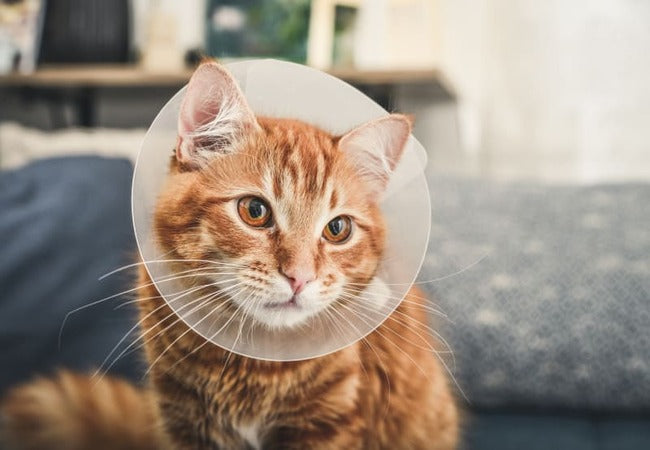Vet‑Approved 2025 Guide: Cat Surgery Aftercare FAQs – Recovery Tips & Expert Care 🐱🩺💉

In this article
Vet‑Approved 2025 Guide: Cat Surgery Aftercare FAQs – Recovery Tips & Expert Care 🐱🩺💉
By Dr. Duncan Houston BVSc
After your cat’s surgery, it’s normal to have lots of questions 😺🛏️. This comprehensive FAQ guide covers the most common post-op concerns: digestion, urination, incision care, pain signs, and comfort tips—plus top tools from Ask A Vet, to enhance recovery.
1. When will my cat poop? 🚽
Cats should have a bowel movement within 24–48 hours after surgery. Straining, vocalizing, or no stool by 48 hours could signal constipation, common due to dehydration or opioids. Avoid enemas; consult your vet. Remedies may include increased fiber, probiotic food toppers, hydration, or prescription stool softeners.
2. Is urine incontinence normal?
Usually, cats urinate normally post-op. If your cat is lethargic or on sedatives, they may urinate outside the box temporarily. Persistent incontinence isn’t normal—risk of infection or injury—so contact your vet if it continues beyond a couple of days.
3. What if my cat pees outside the box?
Stress, medications, or unfamiliar litter boxes may cause accidents. Use non-clumping or paper-based litter, low-sided boxes, and place them in the cat’s recovery area. Introduce new litter types before surgery. Persistent accidents should be discussed with your vet.
4. Frequent urination—normal?
Yes, especially if IV fluids were used—frequent, clear urine in the first 24–48 hours can be expected. However, if your cat strains, cries, or shows blood in the urine beyond that period, seek veterinary care immediately—signs of stress cystitis or surgical complications.
5. What if my cat won’t pee?
Inability to urinate is an emergency—especially for male cats. If 12+ hours pass with no urination, contact an emergency vet right away to relieve potential blockages.
6. How can I tell if my cat is in pain?
Cats hide pain—look for hiding, reduced appetite, grooming less, lethargy, or avoiding litter boxes. Continue all pain meds as prescribed and reach out if pain seems uncontrolled or behavior doesn’t improve.
7. Cone? For how long?
Yes—whether traditional, soft, inflatable, or a bodysuit, cats must wear a barrier for 7–14 days, depending on the procedure. Prevent licking at the incision until it’s fully healed.
8. How should I feed & hydrate?
Offer half the usual food a few hours after surgery to reduce nausea, then resume normal meals gradually. Always provide fresh water—consider adding moisture-rich food or using a fountain.
9. Activity Restrictions?
Soft‑tissue surgeries require 1–2 weeks of restricted activity, while orthopedic procedures often need 6–12 weeks of limited movement or crate rest. Keep them quiet—no jumping or running.
10. How to monitor incisions?
Check incisions 4× daily for redness, swelling, discharge, or sewing. Use daily photos to track healing. Bruising and slight oozing in the first 24 hours is okay; persistent swelling or odor warrants a vet call.
11. When do stitches come out?
External sutures/staples are usually removed 7–14 days post-op; internal sutures dissolve on their own. Confirm timing based on your vet’s guidance.
12. What about sneezing or coughing?
Some post-op sneezing or coughing is normal due to anesthesia or intubation. If it persists beyond a couple of days or worsens, contact your veterinarian.
13. Panting after surgery?
Heavy panting or rapid breathing may indicate pain, stress, overheating, or respiratory issues. If it’s persistent or severe, seek veterinary evaluation.
14. Why is my cat hiding in the litter box?
Stress, pain, or disorientation may cause cats to hide in litter boxes. Make sure the area is quiet, offer comfortable bedding nearby, and reassure them gently. Monitor behavior and consult your vet if anxiety persists.
15. When should I call the vet?
- No urination by 12–24hrs
- No bowel movement by 48hrs
- Straining, vocalizing, or visible blood
- Lethargy, poor appetite beyond 24hrs
- Rapid breathing, fever, uncontrolled vomiting
- Wound issues: redness, swelling, odor
- Behavior changes or persistent anxiety
🛠️ Comfort Tools & Enrichment
- Ask A Vet: Remote aftercare support—get peace of mind on meds, wound photos, and behavioral changes.
- Woopf: Soothing wraps, comfy bedding, and treat puzzles to reduce stress and engage your cat.
- Purrz: Calming pheromone diffusers, recovery suits, and soft music to create a serene healing environment.
🏁 Final Thoughts
Every cat's recovery is unique, but understanding what’s normal—and when to be concerned—empowers you to care confidently. Combine supportive aftercare routines with expert tips and calming tools to ensure your kitty heals safely and peacefully. For personalized guidance tailored to your cat, reach out via Ask A Vet. Wishing your fur baby a smooth, happy recovery! 🐾❤️


